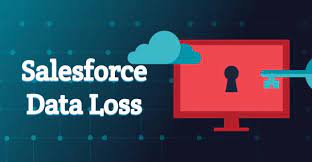For years, the primary stumbling block hindering organizations from embracing cloud adoption has been the concern over data security, solutions, and safety. However, recent surveys indicate a significant shift, with cloud service providers like Salesforce playing a pivotal role in building trust, with adoption rates soaring as high as 65%. UI and Data Loss-user interfaces may be the weak link in your data security.
As the leading CRM platform and a top-tier cloud solution boasting over 99% uptime, Salesforce instills confidence in its users. Yet, a lingering question remains: is your data truly secure? The resounding answer is yes; Salesforce’s service disruptions are exceptionally rare. However, the risk of data loss often stems from how companies interact with their Salesforce environment and handle cloud data manipulation.
Each organization operates within its own instance of Salesforce, accessing data via standard applications like CRM or third-party tools. However, each interaction with this cloud data carries the potential for inadvertent errors and unwanted outcomes.
Let’s dive into the primary causes of data loss within Salesforce in this insight:
- Accidental or Malicious Deletion: Users may unintentionally or intentionally delete records, either individually or in bulk using utilities like the mass delete feature.
- Flawed Code: Poorly written code can inadvertently lead to data loss by making unintended changes. Despite rigorous testing, programming errors can occur, often resulting in unforeseen consequences that are challenging to trace and rectify.
- Erroneous Data Import: Data import tools like data loader or import wizard can inadvertently populate records with incorrect data due to mapping errors, resulting in a significant volume of inaccurate data across multiple records.
- Faulty SOQL Queries: Executing faulty queries within the developer console can swiftly lead to data loss by inadvertently updating multiple records. It is crucial to maintain backups before executing mass updates to mitigate risks.
- Integration Issues: Even minor integration glitches can trigger incorrect record updates, particularly with powerful automation tools that can update vast record volumes. Without proper backups, rectifying such errors becomes exceedingly challenging.
- New releases: Not completely understanding the implication of Salesforce releases can cause unneccessary to your data, leaving it open for loss by users.
To mitigate the risk of accidental data loss, enhancing the Salesforce user interface (UI) is paramount. The UI’s design and flexibility, largely controlled by administrators and developers, significantly influence user interaction and data integrity.
Benefits of an optimized Salesforce UI include:
- Reduced likelihood of data loss
- Enhanced data management accuracy
- Increased productivity
Here are strategies to optimize the Salesforce UI and minimize the risk of accidental data loss:
- Conduct Detailed User Research: Understand user personas and their tasks to tailor the UI accordingly, addressing common pain points and optimizing task completion times.
- Develop User-Friendly Components: Leverage Salesforce’s built-in features or custom components to streamline routine activities and enhance usability. Explore add-ons or develop custom solutions as needed to ensure data accuracy.
- Present Minimal Information: Reduce the risk of data input errors by displaying only essential fields and leveraging visibility controls to show components as needed. Utilize lookup filters and picklists to minimize erroneous data entry.
- Maintain Consistency and Clear Error Messaging: Keep field ordering and page layouts consistent to avoid user confusion. Implement clear error messages to guide users and prevent incorrect data submission.
While Salesforce offers robust data management capabilities, human error remains a risk factor. By implementing thoughtful UI enhancements and adhering to best practices, organizations can minimize the likelihood of data loss and ensure data integrity.













